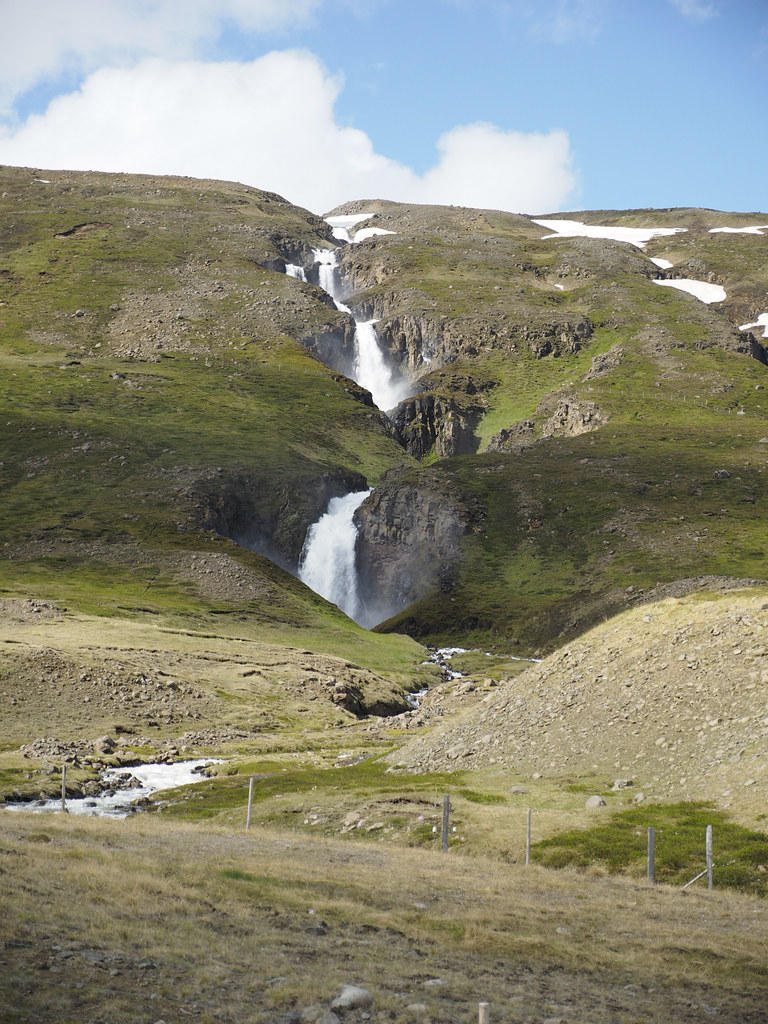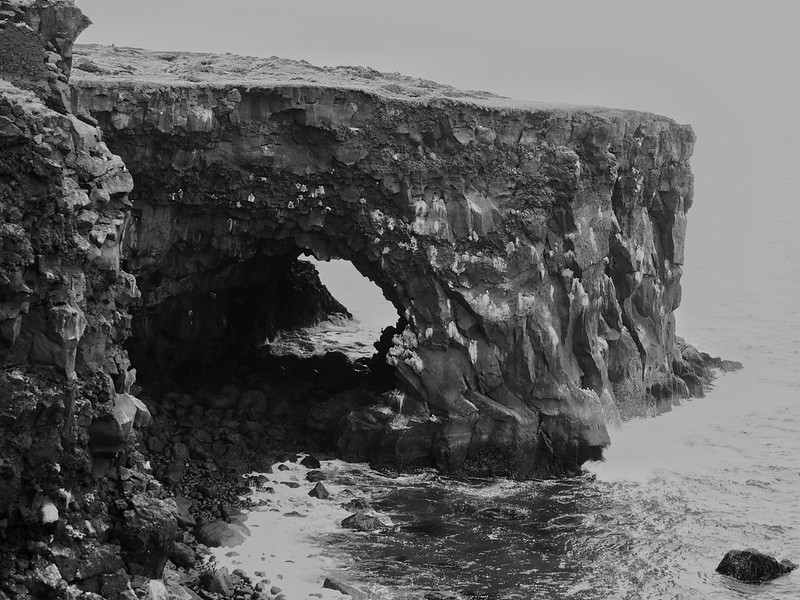We're home now. The flight was uneventful, although someone picked up Sally's bag from the carousel at JFK by mistake. He figured it out before leaving the airport on his next flight, so it just cost us some time and a bit of energy. The Delta staff were very helpful.
On behalf of Sally & Me, I'd like to thank you all for following this trip. Putting together the blog was a bit of work each day, but it also helped me to organize my thoughts about the trip as we went along and will act as a journal when I want to refer back later. Sally's proof reading and editorial suggestions were critical to getting it to the level you saw.
Did I enjoy the trip? Absolutely.
Is the scenery in Iceland all it's cracked up to be? Yes, and No.
If you're looking to compare the waterfalls, or geysers, or mountain ranges, or coastline rock formations, or volcanos with the most dramatic in the world, or even in the US, then Iceland loses. In my opinion, none of the falls in Iceland are as dramatic as Niagra Falls, or as beautiful as any of several in Yosemite. The coastline in Iceland competes with, but doesn't beat, the coastline in Acadia National Park, Hawaii, California, ... . The mountains are awesome, but can't compare with the Sierra Nevada, the Grand Tetons or the Rockies. You can climb up to the volcanos, but none as big as those in Hawaii, which you can practically drive right up to. Iceland's Vatnajokull glacier is the biggest in Europe, but not the biggest in the world, by a long stretch. Yellowstone has far more geysers than Iceland, although only Iceland has Geysir.
But ... They all exist in a country 3/4 the area of New York State. And they are everywhere you go (outside of Reykjavik). You just drive along any road, and you'll see something amazing, shortly. The waterfalls visible from the main roads are countless. You can see three of the largest glaciers in Iceland from a main road, without exiting your car. Parts of the terrain are so bizarre that NASA sent astronauts there to train for lunar missions.
For such a small country, Iceland is amazingly empty. Often, we would drive for miles and see no other cars, no other people,(but always sheep and goats). At 332,000 people and 40,000 square miles, it has the population of Rockland County spread out across 3/4 of New York State. And 200,000 of them live in the Reykjavik area, making the rest of the country very, very sparse. So while it's small, the emptiness makes it feel bigger.
We had mostly pleasant stays in our hotels (and Sally managed some complimentary upgrades; I don't know how she does that). Some of the rooms were tiny, and some were very comfortable; all but one were very clean and very well maintained. One room was weird: Japanese-themed decorations, including a wooden soaking tub. No shower.
The Icelanders were uniformly friendly and as helpful as they could be to us ignorant American travelers. They smiled and laughed with us as we struggled to pronounce place names and even their names. They tried hard to accommodate our strange eating habits.
So ... I'd recommend this as a worthwhile trip. But I'd see the USA (in your Chevrolet or otherwise) first.
Thanks for reading. Hope you found it interesting and enjoyable.
Bassman
Monday, June 20, 2016
Fun facts about Iceland
- The only limited-access highway in the country runs from the Reykjavik suburbs to the airport.
- Most of the main roads outside of Reykjavik, including the Ring Road, are narrow double-lane roads with many single lane river crossings. Some of the Ring Road is gravel, as are many other main roads.
- I've been on narrow roads around the world where one car has to pull over to let the oncoming car pass. I've never been in a 4 mile tunnel that's a single lane, and has cutouts dug in the rock so you can pull over to let an oncoming car (or bus or truck) pass.
- Until 30 or 40 years ago, all of the roads outside of Reykjavik were gravel. I drove maybe 80 miles on gravel roads, which probably doubles my lifetime experience. I fully expected Thrifty, our car rental company, to ding me for dings (ha ha) from the gravel, but the agent smiled and said "no problems, have a nice day".
- The national speed limit is 90 kph (55 mph) on paved roads and 80 kph (49 mph) on gravel roads. There's relatively little speeding. I put the cruise control a couple over the limit and wasn't passed, and didn't pass anyone else, hardly at all.
- We drove about 1,300 miles in the 9 days we had the car, about 1/3 more than I had guessed we would.
- I've driven all over the US, Canada, the Caribbean, the British Isles, Australia, New Zealand and Western Europe. This was the hardest driving I've done. It is because the roads are so narrow, with no shoulder at all. Guardrails are also rare. You try passing an oncoming tour bus on a narrow curve on the side of a cliff and see how you feel.
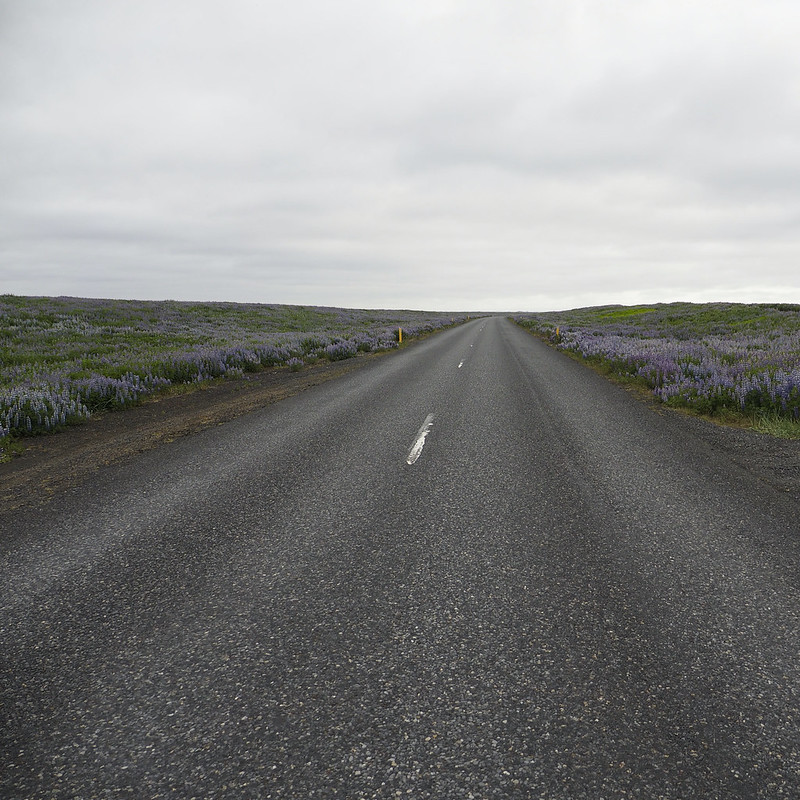 |
| The Ring Road, June 2016 |
- The Icelanders we met were uniformly friendly, and spoke good to excellent English. The biggest language problems we had were with guest workers from Eastern Europe or Asia, who supplement the labor shortage in the booming tourist business.
- It you don't like lamb or fish, your protein options will be limited. There is beef, but it's expensive and not always good. There are often vegetarian dishes. Chicken and pork are rare.
- Fruit in the hotel restaurants is hit-and-miss. They will usually have a limited selection which changes daily, depending on what they can get. Food markets seem to have a good choice, however.
- We noticed a number of Made in USA products. Ford cars, Chiquitta Bananas, Cheerios, Oreos (we saw a lot of food :-) ).
- Unlike Europe, but like the USA, water in restaurants is free and plentiful. We would usually get a pitcher on the table. And the water tastes great. Despite this, bottled water is sold in the markets. Go figure.
- All of the hotels were warm to the point of being stuffy, despite the heat being off for the summer. There is no A/C.
- With the notable exception of Myvatn ("the lake of midges"), there are remarkably few insects in the country. Perhaps all the insects just moved to Myvatn. There are no window screens anywhere.
- There are Subways all areound the country (although not really that many), and a few Quiznos. We saw one Dunkin Donuts in Reykjavik. No other US fast food chains.
- It rains often, but not always a lot. We only had a few days out of twelve with no rain. I don't think we had any days without significant cloud cover, even when it was "sunny". On the other hand, it's been raining for the last 16 hours as we sit on the plane waiting to depart. For the most part, people don't let it interrupt their lives.
- Every house and farm outside of the city has a name. It's not the name of the family that lives there, or anyone who ever lived there. The names are apparently permanent. There are street signs that point down the side road or driveway to the house. That's how you find things, not by a house number on the road: "Olaf? He lives at Stafafell east of Hofn".
 |
| Not the same as a street address, June 2016 |
- The description of menu items is often just an approximation, although it never says that. The menu might offer a shrimp sandwich. What you get is a egg salad with a couple of shrimp on top.
- The French fries are usually very good.
- Some of the local beers are very good: Viking Classic is a deep golden ale, and any of the Einstocks would make a good choice. The beers run $8-$10 in a restaurant.
- All of the wine is imported, usually from the US, Chile or Australia. That makes sense, as no fruits are grown in the country. Most of the wine we sampled was nothing special.
- The coffee comes in both American style and Euro style, e.g. Espresso. The American style coffee tastes just as good as the coffee in America: in other words, highly variable. We saw no Starbucks, and one DD.
- There are pretty much no trees. There are shrubs in some areas, which are only a couple of feet high. The local joke goes "if you find yourself lost in an Icelandic forest, just stand up". I found this to be true on a hike into the hills, where I never lost sight of where I started down by the Ring Road.
- We drove past endless numbers of farms. The only crop we saw that we recognized was hay. But it is spring, and the crops wouldn't have grown yet.
- There are some amazing sights to see: the major waterfalls, cliffs facing the ocean, the glaciers. But then you're just driving along and some farmer has a beautiful waterfall or other natural wonder in his backyard. And this is everywhere.
- If you read the description of the Blue Lagoon and think that it sounds very commercial and touristy, you're right. Though our Icelandic friend said she'd been there several times and enjoyed it.
- Everywhere you drive outside of the city, there are sheep and goats wandering around. Sometimes right on the side of the road. Sometimes (not often) crossing the road. They seem to treat the fences that define each farm as suggestions. You can be crossing the remotest, most barren lunarscape in the mountains on a dirt road and there will be three sheep grazing in the moss growing on the lava.
Sunday, June 19, 2016
Snaefellsjokull National Park
Occupying the western tip of the Snaefellsnes Penninsula, the Snaefellsjokull National Park is centered around the volcano and glacier of the same name. Sadly, the mountain was still socked in and not visible when we awoke this morning. And it was still raining and breezy. Not the best of days to visit a national park, which is all about the great outdoors.
Last night's dinner at the Hellner was a bit frustrating. There were only three dinner entrees, one had garlic, and the other two didn't appeal to Sally. So she had some tasty fish soup for dinner. I had chicken for the first time this trip, and it was also tasty. There was a local wedding reception going on in the restaurant, with about half the tables occupied by guests. They seemed to be enjoying themselves despite the rain and all. But I guess they're used to it, as they live in Iceland.
After breakfast, I went for a walk along the coast that started right behind the hotel. The rain let up shortly after I left, although everything was very muddy and wet. The scenery was awesome and I had a good time.
We checked out and headed into the park. Our plan was to take the road around the park, and stop where it looked interesting. Then head to Reykjavik and find lunch along the way. The estimated driving time for the whole thing was 4.5 hours, plus any stops we took.
We made a couple of quick stops, where we both got out and walked to a viewpoint, or just I got out.
At the extreme west end of the park (and the penninsula) a small road headed off the main road towards the sea. I had remembered reading about this, and one travel writer said it was a bumpy ride but worth it. So we started down a paved road. A few miles in there was a small parking area and a few signs, so we stopped (of course). Turns out that the buried body of a Viking from the early settlement days was found there, along with a sword and other tools and artifacts. In addition, there was a very pretty white sand beach with some nice rock formations.
We continued down the road, which immediately turned to dirt. Or I should say, rocks. Actually, rutted dirt and rocks. By far the worst road I ever drove on. Walking would be rough on this road. But we stuck it out and got to the end, where there was a terrific lighthouse.
And more rocks, of course.
And that was about it for the park. After picking our way back on the dirt and rock road to the main road, we continued on out of the park. After passing a few towns which had nothing to offer, we found the Hraun Restaurant in Olafsvik. Sally had a burger and fries; I had a pizza. It might have been the best lunch we had on the trip (although the pizza at Daddi's in Myvatn could tie it). Huge menu, friendly service, and very reasonable: we got out for $32, which is great in this country.
We're now back in Reykjavik, at the Alda Hotel, for our last night. We have a 7:45 am pickup to go to the airport and home. After walking a bit in either direction from the hotel, we settled on eating in the hotel restaurant. The owner/chef was there, and insisted Sally could eat almost anything on the menu - so she had barbecue ribs, which is a very rare treat. And they were delicious, despite the absence of garlic.
Before we came, we found out that you can charge anything here, and cash is really not necessary. Being a bit cautious, I bought 10,000 krona (about $80) at the airport when we arrived. Today we used 1,000 kr. for a tunnel toll, and the other 9,000 kr. for dinner. Dinner was actually 9,060 kr., so I charged the extra 60 kr. - about 48 cents. If you're ever here, rest assured that you really don't need any cash anywhere(1).
----------
(1) While we didn't find anything that you couldn't charge, there are a number of places that don't accept American Express, most notably gas stations. We always travel with at least one AmEx and one Visa, just to be sure.
Last night's dinner at the Hellner was a bit frustrating. There were only three dinner entrees, one had garlic, and the other two didn't appeal to Sally. So she had some tasty fish soup for dinner. I had chicken for the first time this trip, and it was also tasty. There was a local wedding reception going on in the restaurant, with about half the tables occupied by guests. They seemed to be enjoying themselves despite the rain and all. But I guess they're used to it, as they live in Iceland.
After breakfast, I went for a walk along the coast that started right behind the hotel. The rain let up shortly after I left, although everything was very muddy and wet. The scenery was awesome and I had a good time.
 |
| Cove, June 2016 |
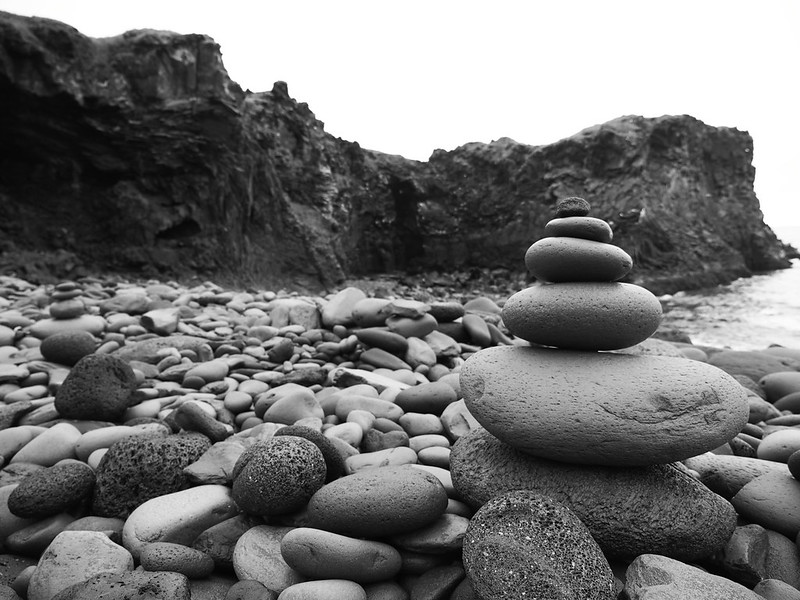 |
| Cairns on the beach, June 2016 |
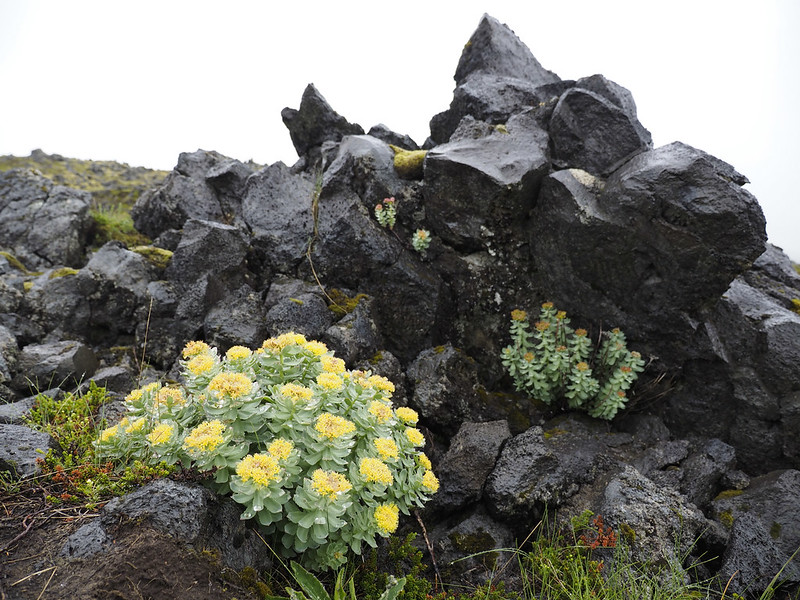 |
| A flower grows in rock-land, June 2016 |
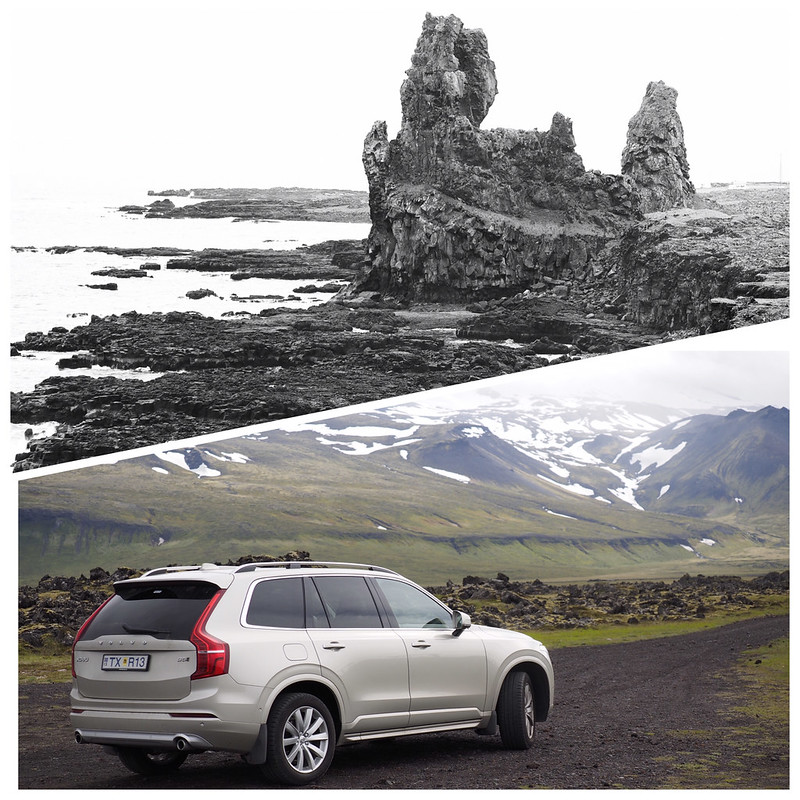 |
| Still no sign of a glacier, June 2016 |
At the extreme west end of the park (and the penninsula) a small road headed off the main road towards the sea. I had remembered reading about this, and one travel writer said it was a bumpy ride but worth it. So we started down a paved road. A few miles in there was a small parking area and a few signs, so we stopped (of course). Turns out that the buried body of a Viking from the early settlement days was found there, along with a sword and other tools and artifacts. In addition, there was a very pretty white sand beach with some nice rock formations.
We continued down the road, which immediately turned to dirt. Or I should say, rocks. Actually, rutted dirt and rocks. By far the worst road I ever drove on. Walking would be rough on this road. But we stuck it out and got to the end, where there was a terrific lighthouse.
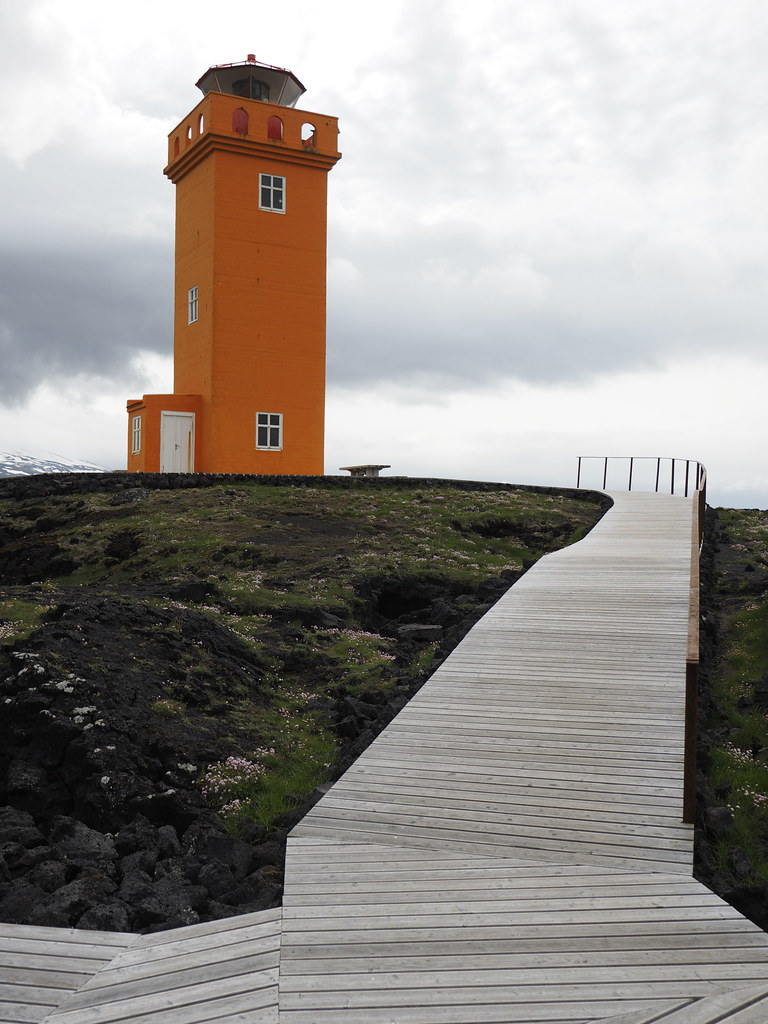 |
| Orange Lighthouse, June 2016 |
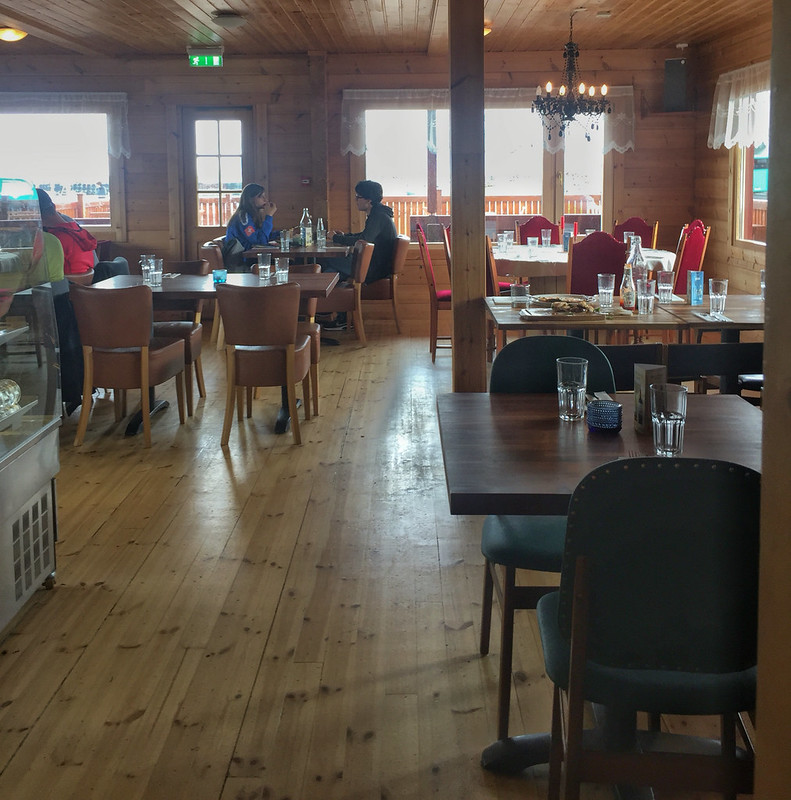 |
| Hraun Restaurant - good food, June 2016 |
We're now back in Reykjavik, at the Alda Hotel, for our last night. We have a 7:45 am pickup to go to the airport and home. After walking a bit in either direction from the hotel, we settled on eating in the hotel restaurant. The owner/chef was there, and insisted Sally could eat almost anything on the menu - so she had barbecue ribs, which is a very rare treat. And they were delicious, despite the absence of garlic.
Before we came, we found out that you can charge anything here, and cash is really not necessary. Being a bit cautious, I bought 10,000 krona (about $80) at the airport when we arrived. Today we used 1,000 kr. for a tunnel toll, and the other 9,000 kr. for dinner. Dinner was actually 9,060 kr., so I charged the extra 60 kr. - about 48 cents. If you're ever here, rest assured that you really don't need any cash anywhere(1).
----------
(1) While we didn't find anything that you couldn't charge, there are a number of places that don't accept American Express, most notably gas stations. We always travel with at least one AmEx and one Visa, just to be sure.
Saturday, June 18, 2016
It's a network problem
We're in Hellner, on the Snaefellsnes peninsula. The Internet service both thru the hotel and my wifi hotspot stink, so I can't post any pictures. But here's what we did today:
- we drove a lot
- we had really good home made ice cream at a farm
- we saw some small towns
- we drove a lot on dirt roads
- we couldn't find a place to eat lunch so we had bread, nuts, and some fruit in the car
- we drove a lot more
- we saw sheep, goats, horses, and a few cows
- we checked into the hotel, where we can't see the glacier from our room due to the weather
- it's been raining and windy for the last four hours
I'll try and post a more detailed write up, with pictures, tomorrow.
- we drove a lot
- we had really good home made ice cream at a farm
- we saw some small towns
- we drove a lot on dirt roads
- we couldn't find a place to eat lunch so we had bread, nuts, and some fruit in the car
- we drove a lot more
- we saw sheep, goats, horses, and a few cows
- we checked into the hotel, where we can't see the glacier from our room due to the weather
- it's been raining and windy for the last four hours
I'll try and post a more detailed write up, with pictures, tomorrow.
Snaefellsnes!
(Gesundheit! You sneezed, didn't you?)
As I wrote yesterday, we were surprised by and really liked the Hofsstadir Guesthouse. Here are a few exterior shots and the view out the back. The food for both dinner and breakfast was very fresh and tasty.
Today we had another new driving experience on our way to the Fosshotel Hellnar on the Snaefellsnes peninsula: 60 miles on dirt and gravel roads. The speed limit on the main roads (as small as they are) is 90 kph (55 mph); on the dirt roads, it was slowed down a bit to 80 kph (49 mph). Not much of a difference. But a much less pleasant drive. Of course, all of the bridges on the dirt highways were single lane; surprisingly, we saw a fair amount of traffic. Probably because this is the main highway into the north shore of the Snaefellsnes peninsula (Gesundheit!)
We also came across these kookie karacters along the road. I have no idea what they are. They do look like they are attracted to each other.
And more horses. There are tons of sheep and goats, but a fair number of horses. Not too many cows. We saw no pigs or chickens at all. Most restaurants have lamb on the menu, many have beef, few have chicken, and only the hot dogs have pork. Several restaurants have horse(1).
As usual, we drove through a few small towns. None were unique enough to warrant getting out and walking around. But we made a small detour for ice cream (very good!), and to visit the Eriksstadir, a recreation of the house that Eric the Red, and his son Lief Erikson, lived in 1,000 years ago. The short story is that Erik was kicked out of Iceland for being a bad guy, discovered and settled in Greenland and lived there. Lief made it to Newfoundland, but the weather was too harsh compared to either Iceland or Greenland at the time, so he returned to Greenland. Both died in Greenland. The sod hut was interesting, and had much in common with other primitive peoples: small & smoky, and family, children and slaves all in one room.
Although the house is a recreation built in 2000, it is built as the Vikings in Iceland would have: made from driftwood (there's little wood in Iceland), no nails, covered with sod for insulation. The loom is significant, as according to the sagas, it played a role in Erik's troubles with the law and his wife.
Late in the afternoon we got to our penultimate destination, the Fosshotel Hellner right outside the Snaefellsnes National Park in western Island. I'd show you some pictures, but it started raining and blowing about when we got here late in the afternoon and hasn't stopped yet. The desk clerk says there's a glacier right outside our room, but we haven't seen anything but fog and rain. We haven't had any sustained and heavy rains yet, just frequent short ones. With any luck, it will clear up shortly.
----------
(1) Wrote one on the menu chalkboard: "Eat like a Viking: Horse!"
As I wrote yesterday, we were surprised by and really liked the Hofsstadir Guesthouse. Here are a few exterior shots and the view out the back. The food for both dinner and breakfast was very fresh and tasty.
 |
| Hofsstadir Guesthouse, June 2016 |
 |
| Bridge over no water, June 2016 |
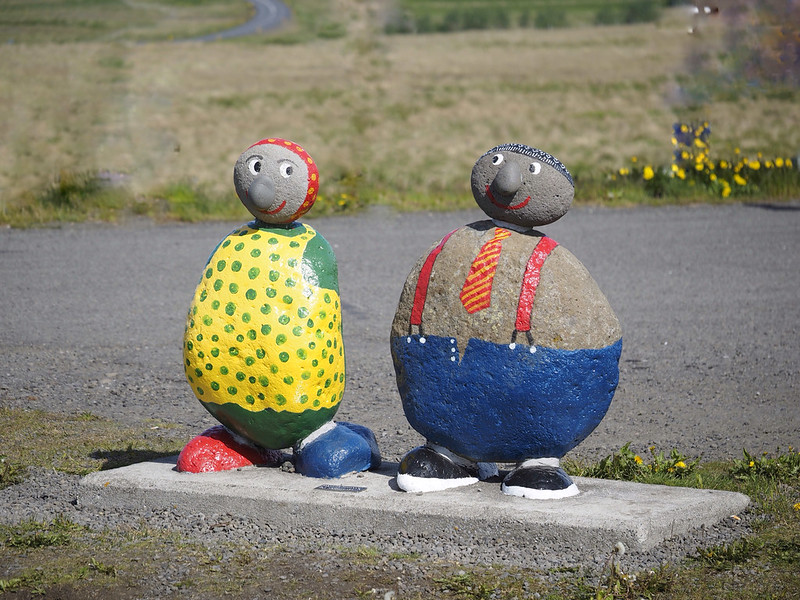 |
| Sweethearts., June 2016 |
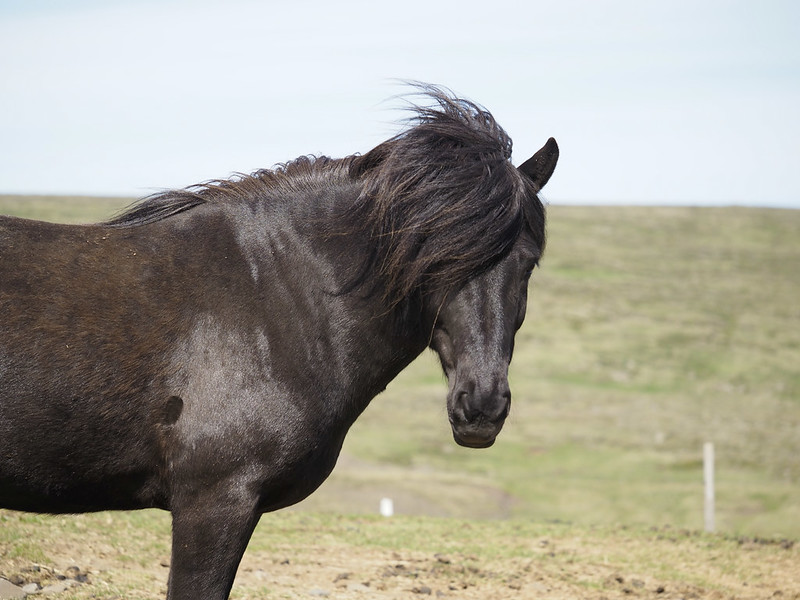 |
| Don't look at me that way, I had the fish, June 2016 |
Although the house is a recreation built in 2000, it is built as the Vikings in Iceland would have: made from driftwood (there's little wood in Iceland), no nails, covered with sod for insulation. The loom is significant, as according to the sagas, it played a role in Erik's troubles with the law and his wife.
Late in the afternoon we got to our penultimate destination, the Fosshotel Hellner right outside the Snaefellsnes National Park in western Island. I'd show you some pictures, but it started raining and blowing about when we got here late in the afternoon and hasn't stopped yet. The desk clerk says there's a glacier right outside our room, but we haven't seen anything but fog and rain. We haven't had any sustained and heavy rains yet, just frequent short ones. With any luck, it will clear up shortly.
----------
(1) Wrote one on the menu chalkboard: "Eat like a Viking: Horse!"
Another sunset
Friday, June 17, 2016
Scenic views
We were out of Myvatn at 9:05 this morning. Packed, breakfast, car loaded, and wheels rolling. As we drove away from the Hotel Laxa, we heard the tap-tap-tap of insects smashing into our windshield. I would say we were both happy to leave. The strange thing is that Myvatn is a big outdoors destination for both Icelanders and foreign visitors. The area is loaded with hiking trails, nature walks, and other outdoor activities. Many of the people we saw in our hotel and in town were dressed for hiking and carrying packs. I just don't get how you deal with the midges.
Our first stop was the last of the "name" waterfalls, Godafoss (God's Waterfall). It's not extremely high, but is quite broad and throws a lot of water. It's also handicapped accessible for viewing, as it's only a few steps from the car.
We had another 2 1/2 or 3 hours of driving ahead, and no major sights to see. Or, I should say, 2 1/2 or 3 hours of spectacular scenery as we drove around Trollaskagi, the peninsula of the Trolls. Spoiler alert: we saw no trolls.
The beginning of the penninsular circumnavigation was Akureyi, which is the largest town in the country outside of the Reykjavik region. Population 18,191. We expected to walk around, look at shops, maybe eat lunch. As it turns out, today is National Day and most of the shops except the tacky souvineer ones were closed. So we walked around a bit, got some ice cream and kept going.
Our next target as we swept up the east side of Troll-land was Silglufjordur, which was the herring capital of Iceland back in the day. We drove through town (which took about a minute), then circled back to find a lunch spot. We ate in a cute little shack right on the harbor. What we got was not what we expected, but was okay. The beers were very good. We started to talk to a character sitting and having a coffee, until he started telling us that we had to vote for Trump to save our country. Then we walked away.
As I mentioned in an earlier post, capturing the majesty of the landscape is really hard. There's no place to safely stop on the road; when you can stop your viewpoint is limited; and it takes a lot of time to make these pictures work. So here's just a tease.
We finally found the Hofsstader Guesthouse, our accommodation for the night, after going 15 minutes too far and using Google maps to reorient ourselves. It's really a motel; you drive up to your simple room. But it's clean, functional, has enough room to open both of our suitcases at the same time, and two chairs. And no midges to speak of.
After we unloaded I went out for a little walk before dinner and found the Hofsstadakirkja, yet another cute church in a spectacular setting.
We had a unique driving experience today. I mentioned earlier that most of the small river crossings on the Ring Road (and other roads) are single lane, and it hasn't been a problem with traffic. Today we went through a 3 mile tunnel under a mountain that was single lane! There are cut-outs on one side, and you pull in when you see headlights coming at you. We had to pull over twice. Quite an experience, and I have no pictures for the obvious reasons.
Our first stop was the last of the "name" waterfalls, Godafoss (God's Waterfall). It's not extremely high, but is quite broad and throws a lot of water. It's also handicapped accessible for viewing, as it's only a few steps from the car.
 |
| Godafoss, Sally & Bassman, June 2016 |
The beginning of the penninsular circumnavigation was Akureyi, which is the largest town in the country outside of the Reykjavik region. Population 18,191. We expected to walk around, look at shops, maybe eat lunch. As it turns out, today is National Day and most of the shops except the tacky souvineer ones were closed. So we walked around a bit, got some ice cream and kept going.
 |
| Akureyi is mostly closed today, June 2016 |
 |
| Pretty harbor, pretty lady, and a weird duck, June 2016 |
 |
| Scenes from the fjords, June 2016 |
After we unloaded I went out for a little walk before dinner and found the Hofsstadakirkja, yet another cute church in a spectacular setting.
 |
| Hofsstadakirkja, June 2016 |
Thursday, June 16, 2016
Fire & Rain
We slept pretty well in our tiny room last night, then had a breakfast which matched dinner for quality. The cereal was a bit stale, the only fresh fruit was some watermelon slices. There was bread and butter. The coffee was okay. Then we were off to see the sights of this region.
The headline site for me is Dettifoss, the largest waterfall in Europe (in terms of water volume). It's about an hour away, and there's a new paved road to get you there. The GPS' all seem to know only about the older unpaved road, but 20 miles on a dirt road didn't sound exciting. While the weather was okay(1) when we left, about five miles from the falls, the fog got so thick that I had to drive slowly. Not a good omen! Fortunately, we went over a small ridge and the fog disappeared, so it was dry when we got to the parking lot.
You have to walk about a half mile to get to the falls through rocky terrain. Once you get to the viewing areas, the mist from the falls are coming your way. This makes just standing there a bit uncomfortable, but makes photography very difficult - the mist and water drops get on your lens easily, ruining your pictures, if you're not really careful. I had to clean the lens repeatedly, then quickly frame, focus and take the pictures in between waves of mist as the wind changed.
All of these pictures are full color - I didn't convert anything to monochrome. There's just not a lot of color between the grey rock, the gray sky and the grey water. The picture on the lower right shows Selfoss, another really big waterfall about half a mile upstream. The Jokulsla River, which makes these falls, flows north about 20 miles from here to empty into the Greenland Sea, which looks to me on the map like part of the Arctic Ocean.
This spot is 65.8 degrees north; the Arctic Circle is about 66.5 degrees, or about 50 miles away. This is the furthest north Sally and I have ever been on the ground(2).
We drove back to town for lunch, where we found Daddi's Pizza. Which is garlic-free, and decent. Actually, it tasted great to us after the last couple of meals. It started raining as we were driving there, but cleared up while we were eating.
We may wind up back there for dinner.
There are any number of hikes in and around Lake Myvatn. I did none of them. Here's one reason:
These midges dive bomb you the minute you step out of a building or the car, get in your hair, land on your eyeglasses, and go in other unpleasant places. The only saving grace is they don't bite. If they did, this place would be uninhabitable. Frankly, we don't know how the locals can stand to live here. Incidentally, the sign says "Don't open this door" (in Japanese). I wonder why they don't want the door open? Here's a clue as to how bad they are: the hotel had bug nets to cover your head for sale, on display at reception.
The other reason is that it keeps raining on and off. I've got rain gear, and I don't mind if I'm doing something interesting and its starts to rain lightly. But a big part of hiking is enjoying being outside. And I don't really enjoy hiking in the rain. And I really hate hiking in an insect infestation.
We did make a couple more stops after lunch. This area was created by volcanic activity. There are thermal hot spots and volcanos all over the region. So we went first to the Krafla volcano area. There's a huge thermal power plant there supplying hot water for heating and electricity generation. After an eruption a few hundred years ago, the Viti crater was formed and filled with green water (according to the guide books - it looked blue to us).
Then to an active area filled with fumeroles and bubbling mud pots. Similar to Yellowstone, but smaller. They were interesting and very accessible.
We're back at the hotel now, enjoying happy hour and counting down to when we leave in the morning.
----------
(1) "Okay" for Iceland weather means it's not raining. Too hard.
(2) I'm not counting air travel; I flew directly over the North Pole once. Sally and I both flew to Asia over Alaska, where we were at least 63 degrees north but perhaps further.
The headline site for me is Dettifoss, the largest waterfall in Europe (in terms of water volume). It's about an hour away, and there's a new paved road to get you there. The GPS' all seem to know only about the older unpaved road, but 20 miles on a dirt road didn't sound exciting. While the weather was okay(1) when we left, about five miles from the falls, the fog got so thick that I had to drive slowly. Not a good omen! Fortunately, we went over a small ridge and the fog disappeared, so it was dry when we got to the parking lot.
You have to walk about a half mile to get to the falls through rocky terrain. Once you get to the viewing areas, the mist from the falls are coming your way. This makes just standing there a bit uncomfortable, but makes photography very difficult - the mist and water drops get on your lens easily, ruining your pictures, if you're not really careful. I had to clean the lens repeatedly, then quickly frame, focus and take the pictures in between waves of mist as the wind changed.
 |
| Dettifoss and Selfoss, June 2016 |
This spot is 65.8 degrees north; the Arctic Circle is about 66.5 degrees, or about 50 miles away. This is the furthest north Sally and I have ever been on the ground(2).
We drove back to town for lunch, where we found Daddi's Pizza. Which is garlic-free, and decent. Actually, it tasted great to us after the last couple of meals. It started raining as we were driving there, but cleared up while we were eating.
 |
| Daddi's for lunch, June 2016 |
There are any number of hikes in and around Lake Myvatn. I did none of them. Here's one reason:
 |
| Midge city, June 2016 |
The other reason is that it keeps raining on and off. I've got rain gear, and I don't mind if I'm doing something interesting and its starts to rain lightly. But a big part of hiking is enjoying being outside. And I don't really enjoy hiking in the rain. And I really hate hiking in an insect infestation.
 |
| Viti: what color is it?, June 2016 |
 |
| The ground is alive, June 2016 |
We're back at the hotel now, enjoying happy hour and counting down to when we leave in the morning.
----------
(1) "Okay" for Iceland weather means it's not raining. Too hard.
(2) I'm not counting air travel; I flew directly over the North Pole once. Sally and I both flew to Asia over Alaska, where we were at least 63 degrees north but perhaps further.
Wednesday, June 15, 2016
South to north
We left our king-sized suite at the Fosshotel Vatnajokull this morning for a trip around the Eastern Fjords of Iceland and over the mountains into the north. We're staying in Myvatn for two nights. The room is not king-sized. In fact, it is by far the smallest and simplest room we've stayed in on this trip. But I'm getting ahead of myself.
We left with an overcast sky, and it soon turned to a light rain as we headed east and turned north along the coast. Fortunately the rain stopped shortly. The first town we came to - any town at all - was Djupivogur, a small fishing town about 70 miles away. For us, it was distinguished by having a clean and no-charge WC. While standing in line there, we struck up a conversation with another couple.
Us: Where you from?
Them: Manhattan
Us: Manhattan, NY?
Them: Yes. Well, actually New Jersey.
Us: Oh really, where in New Jersey? We're from Bergen County.
Them: What? We're from Mahwah! (maybe 8 miles from us)
Us: Saddle River!
By the time we were finished, they knew what street we lived on. We'll almost certainly never see them again.
Refreshed, we continued on to our likely lunch destination, the town of Stöðvarfjörður (say that three times fast), where we found Petra's Stone Collection. Seems like this woman developed an affection for stones, and collected them from 1946 until shortly before she died in 2012 at 89. As the collection grew, it developed a reputation and is now one of the most popular attractions in East Iceland. I should add that there are not many attractions in East Iceland, other than the scenery.
Sally really liked it. I was impressed by the scope of the garden and the thousands of rocks in her collection. Our lunch consisted of a thin slice of ham or chicken and a similar slice of cheese on a roll, and a cookie. But a worthy break in the long ride.
The fjords are impressive. It's very hard to capture them in a photo, especially with the overcast sky and my position being limited to the parking areas on the side of the road. But here's a weak effort.
We finally turned away from the coast and headed inland towards North Iceland. We made no stops here; in fact, we passed pretty much no towns. What we did go through was usually great, and occasionally stunning, scenery. One of the things that struck me were the waterfalls, with no names, in some farmer's backyard. In this one, you can see the fence bordering his property. I pulled off the road into a little cutout he had to park his truck while working in this part of his land.
This one, a little later on, is massive.The upper section is 100 yards away from me. I don't show the property fence, but it's also on private land. There is a real parking area by this one, which is prudent as there were at least five cars and a bus stopped with us.
One of fun facts about the Ring Road is that it's pretty narrow and has no shoulder anywhere. The shot above has a very rare guardrail, but you're usually just riding along a roadbed raised above the land on either side. Fortunately, there's really not much traffic. Most of the river crossings - of which there are many - are a single lane, and we've only had to wait for opposing traffic a couple of times.
We finally arrived at the Hotel Laxa here on the shore of Lake Myvatn and found out that the name "Myvatn" is completely justified. The word means "lake of midges". They swarm around you as soon as you get out of your car. Fortunately, we're told they don't bite, they're just "annoying"(1).
As I mentioned above, the rooms at the Laxa are small. Very small. Even with my widest lens, I couldn't get the whole room in. And there's absolutely no place we can leave our suitcases open, unless we're willing to give up the floor and climb across the bed. And you can see the generous closet and drawer space in the upper half of the picture. We are here for two nights.
On the plus side, we got here early enough to get happy hour pricing on a pair of drinks. On the negative side, dinner in the restaurant was mediocre (Sally's better than mine). And the same high price that we've paid across Iceland: my small portion of overlooked lamb and some kind of square potato thing was $43.
Sally can't wait to leave.
--------
(1) "Annoying" like the cat that peed in my car when I was in college. The car never quite recovered.
We left with an overcast sky, and it soon turned to a light rain as we headed east and turned north along the coast. Fortunately the rain stopped shortly. The first town we came to - any town at all - was Djupivogur, a small fishing town about 70 miles away. For us, it was distinguished by having a clean and no-charge WC. While standing in line there, we struck up a conversation with another couple.
 |
| Eastern Iceland harbor, June 2016 |
Them: Manhattan
Us: Manhattan, NY?
Them: Yes. Well, actually New Jersey.
Us: Oh really, where in New Jersey? We're from Bergen County.
Them: What? We're from Mahwah! (maybe 8 miles from us)
Us: Saddle River!
By the time we were finished, they knew what street we lived on. We'll almost certainly never see them again.
Refreshed, we continued on to our likely lunch destination, the town of Stöðvarfjörður (say that three times fast), where we found Petra's Stone Collection. Seems like this woman developed an affection for stones, and collected them from 1946 until shortly before she died in 2012 at 89. As the collection grew, it developed a reputation and is now one of the most popular attractions in East Iceland. I should add that there are not many attractions in East Iceland, other than the scenery.
 |
| Petra's Rock Garden, June 2016 |
The fjords are impressive. It's very hard to capture them in a photo, especially with the overcast sky and my position being limited to the parking areas on the side of the road. But here's a weak effort.
 |
| Weak fjordal views, June 2016 |
 |
| Backyard waterfall, June 2016 |
 |
| Big backyard waterfall, June 2016 |
We finally arrived at the Hotel Laxa here on the shore of Lake Myvatn and found out that the name "Myvatn" is completely justified. The word means "lake of midges". They swarm around you as soon as you get out of your car. Fortunately, we're told they don't bite, they're just "annoying"(1).
As I mentioned above, the rooms at the Laxa are small. Very small. Even with my widest lens, I couldn't get the whole room in. And there's absolutely no place we can leave our suitcases open, unless we're willing to give up the floor and climb across the bed. And you can see the generous closet and drawer space in the upper half of the picture. We are here for two nights.
On the plus side, we got here early enough to get happy hour pricing on a pair of drinks. On the negative side, dinner in the restaurant was mediocre (Sally's better than mine). And the same high price that we've paid across Iceland: my small portion of overlooked lamb and some kind of square potato thing was $43.
Sally can't wait to leave.
--------
(1) "Annoying" like the cat that peed in my car when I was in college. The car never quite recovered.
Tuesday, June 14, 2016
A quiet day
We woke up today in our spacious suite in the Fosshotel with an entire day of no plans and the prospects of a relaxing day. A little laundry was on the agenda, as it will have a full day to dry before we check out on Wednesday.
We had breakfast in the hotel (all of the hotels on this trip include breakfast in the rate), and then I did a little research about whether I could take a glacier hike in the afternoon. This turned out to not be possible for a number of reasons, largely related to my waiting until the last minute.
We had planned to go and check out the local town, Hofn. With 1,700 residents, Hofn is the largest town we've seen since Reykjavik. It has two gas station/mini-marts, a school, a number of restaurants, and a police station. We drove around the entire town first, which took all of five minutes. Then we drove back to the far end, where the peninsula it's on turns into a large park and nature area. There is a nice walking path around the park, which we covered.
The main wildlife in the park is ducks and Arctic terns. The terns feed by circling above the water, then dive-bombing and catching a fish swimming near the surface. The ducks engaged in a behavior I had never seen before. A large group, perhaps 20, gathered tightly together in the water. Then, on some signal, they all dive under water where (I assume) they feed for a long time - maybe a minute or so. Then they all pop up together in a new location, dozens of yards away from the starting point.
We also had lunch in Hofn, where Sally got the langoustine, which they loosely call lobster. It was quite good.
After lunch, I went for a hike. I found a farm about 30 minutes from the hotel where the farmer lets people look around his property and hike on a couple of trails. He also rents small cottages and rooms. To give you an idea of the property, the rooms (no food, shared bath, no linens) cost $30 per bed. Not high end stuff.
When I got there, I though I was at the wrong place, or my Lonely Planet guide book was outdated because the buildings all looked deserted and decrepit. The large number of sheep wandering in the field kept me around. The farmer drove up after a few minutes, just after a German couple showed up looking for their lodgings. We all followed the farmer into "reception", which was his house. It smelled approximately like a park toilet that hasn't been serviced for days. But he gave me a map, and I left before the Germans started on their arrangements.
The trail started behind the guesthouse and a small church. The guesthouse looked ready to fall over, but the church was very cute. It headed north, away from the ocean and into the foothills. I followed the trail for about 45 minutes out, then lost it and decided to head back. I took a few pictures of the scenery, which really don't do justice to the beauty of being out there in the mountains. And the weather was again great, sunny and mild, with a slight breeze. We've now had 2 1/2 sunny days of six.
On my way back, I noticed a trail marker and realized I had wandered off the trail in the first 1/4 mile, and had been following an unmarked trail. Which explains why the trail seemed to end suddenly. But I enjoyed it nonetheless. If I had been on the marked trail, I suppose I might have seen different stuff, but not necessarily.
On the way back to the hotel, I passed these horses.
The day ended with a nice dinner and a bottle of wine in the hotel restaurant.
We had breakfast in the hotel (all of the hotels on this trip include breakfast in the rate), and then I did a little research about whether I could take a glacier hike in the afternoon. This turned out to not be possible for a number of reasons, largely related to my waiting until the last minute.
 |
| On my mark, dive!, June 2016 |
The main wildlife in the park is ducks and Arctic terns. The terns feed by circling above the water, then dive-bombing and catching a fish swimming near the surface. The ducks engaged in a behavior I had never seen before. A large group, perhaps 20, gathered tightly together in the water. Then, on some signal, they all dive under water where (I assume) they feed for a long time - maybe a minute or so. Then they all pop up together in a new location, dozens of yards away from the starting point.
We also had lunch in Hofn, where Sally got the langoustine, which they loosely call lobster. It was quite good.
 |
| Sod roof, June 2016 |
When I got there, I though I was at the wrong place, or my Lonely Planet guide book was outdated because the buildings all looked deserted and decrepit. The large number of sheep wandering in the field kept me around. The farmer drove up after a few minutes, just after a German couple showed up looking for their lodgings. We all followed the farmer into "reception", which was his house. It smelled approximately like a park toilet that hasn't been serviced for days. But he gave me a map, and I left before the Germans started on their arrangements.
 |
| $30 a night, June 2016 |
 |
| Mountains and mist, June 2016 |
 |
| Family church, June 2016 |
 |
| Mother & child, June 2016 |
On the way back to the hotel, I passed these horses.
The day ended with a nice dinner and a bottle of wine in the hotel restaurant.
Monday, June 13, 2016
South Iceland, Part Deux
With this post, I'll finally be catching up to real time after losing a day to that unfortunate incident at the Blue Lagoon.
We left Vik this morning for our first longish drive - three hours to our next stop. Along the way we had two attractions to see, but we found another one shortly after we left.
Most tourists arrive in Reykjavik and venture as far east as Vik before turning around. This makes for a nice 4-6 day trip. As you move east of Vik, the crowds thin out seriously. As you can see from this shot of the Ring Road. It reminds me of driving across Montana
Anyway, as we were tooling along we passed yet another small parking area along the road (it seems like there's one every few miles) and something about this one caught my eye. There were half a dozen cars parked, and we wheeled in. We found this unnamed waterfall/rapids area that was just georgous.
After leaving and driving for about 5 minutes, I realized I didn't have my sunglasses. Sally wisely suggested I make a U-turn and head back to the picture spot. Then she wisely encouraged me to keep looking after I was about to give up. And, as always, she was right - I found them on the ground in the parking area, dirty but unharmed. A good ending to an annoying situation(1).
From there we pushed on past lava fields, crossed countless rivers on one-lane bridges, saw little unremarked waterfalls spilling down from cliffs and isolated farms back from the road against towering cliffs. We finally arrived at Vatnajokull, the largest glacier in Europe(2) and the center of Vatnajokull National Park. Of course, from the road you can only see the small arms of the glacier as it creeps down out of the mountains. But at Skattafell, you can walk about a mile to the beginning of one of the arms. I decided to pass on that, and instead hiked a couple of miles up to see the Svartifoss waterfall.
The whole island is made of basalt, and they happened to form a nice pipe organ-like formation around this waterfall.
Our next and last official stop for the day was the Glacier Lagoon. The glacial melt has formed a lagoon trapped behind piles of glacial moraine, and the icebergs that calf off float across the lagoon before rushing down a channel and out to the ocean to finally die. There's a big business in boat rides in the lagoon, either in a duck amphibian boat or zodiacs. We just walked along the shore a bit and thought it was better than bouncing and bobbing around in the cold air for 45 minutes. The icebergs are very cool (pardon the pun) and form all kinds of shapes.
Since they melt faster on the submerged side, they will periodically flip over after becoming top-heavy. I saw two of these, sadly Sally saw none.
Around 4:00 pm we finally arrived at our home for two nights, the Fosshotel Vatnajokull. We're just at the eastern most extent of the glacier here. The first room we got put into was tiny-tiny-tiny. And had what I thought was a mediocre view. Sally went and worked her magic and got us switched to a suite literally 2.5x as large, and for a truly nominal price. And here's the view out of our window now:
The white stuff on the distant mountain is the glacier.
Thanks, Sally!
------------------
(1) "Annoying" being a euphemism for "Bassman is cursing at himself under his breath and I can see his back about to spasm".
(2) Iceland is considered part of Europe. It's only 500 miles to Scotland. But only 180 miles to Geenland, which is part of North America. Go figure.
We left Vik this morning for our first longish drive - three hours to our next stop. Along the way we had two attractions to see, but we found another one shortly after we left.
 |
| East of Vik, June 2016 |
Anyway, as we were tooling along we passed yet another small parking area along the road (it seems like there's one every few miles) and something about this one caught my eye. There were half a dozen cars parked, and we wheeled in. We found this unnamed waterfall/rapids area that was just georgous.
 |
| We don't know it's name, June 2016 |
From there we pushed on past lava fields, crossed countless rivers on one-lane bridges, saw little unremarked waterfalls spilling down from cliffs and isolated farms back from the road against towering cliffs. We finally arrived at Vatnajokull, the largest glacier in Europe(2) and the center of Vatnajokull National Park. Of course, from the road you can only see the small arms of the glacier as it creeps down out of the mountains. But at Skattafell, you can walk about a mile to the beginning of one of the arms. I decided to pass on that, and instead hiked a couple of miles up to see the Svartifoss waterfall.
 |
| Svartifoss & columns, June 2016 |
Our next and last official stop for the day was the Glacier Lagoon. The glacial melt has formed a lagoon trapped behind piles of glacial moraine, and the icebergs that calf off float across the lagoon before rushing down a channel and out to the ocean to finally die. There's a big business in boat rides in the lagoon, either in a duck amphibian boat or zodiacs. We just walked along the shore a bit and thought it was better than bouncing and bobbing around in the cold air for 45 minutes. The icebergs are very cool (pardon the pun) and form all kinds of shapes.
Since they melt faster on the submerged side, they will periodically flip over after becoming top-heavy. I saw two of these, sadly Sally saw none.
Around 4:00 pm we finally arrived at our home for two nights, the Fosshotel Vatnajokull. We're just at the eastern most extent of the glacier here. The first room we got put into was tiny-tiny-tiny. And had what I thought was a mediocre view. Sally went and worked her magic and got us switched to a suite literally 2.5x as large, and for a truly nominal price. And here's the view out of our window now:
 |
| Room with a view, June 2016 |
Thanks, Sally!
------------------
(1) "Annoying" being a euphemism for "Bassman is cursing at himself under his breath and I can see his back about to spasm".
(2) Iceland is considered part of Europe. It's only 500 miles to Scotland. But only 180 miles to Geenland, which is part of North America. Go figure.
Subscribe to:
Posts (Atom)
